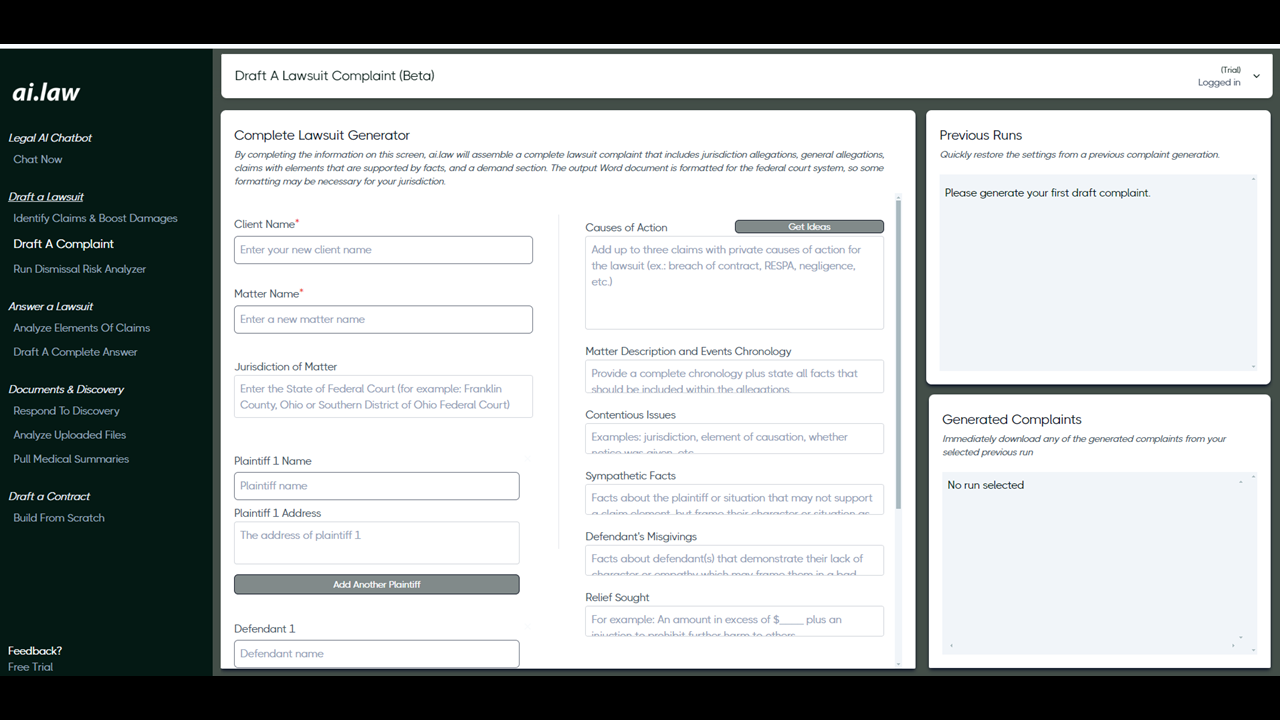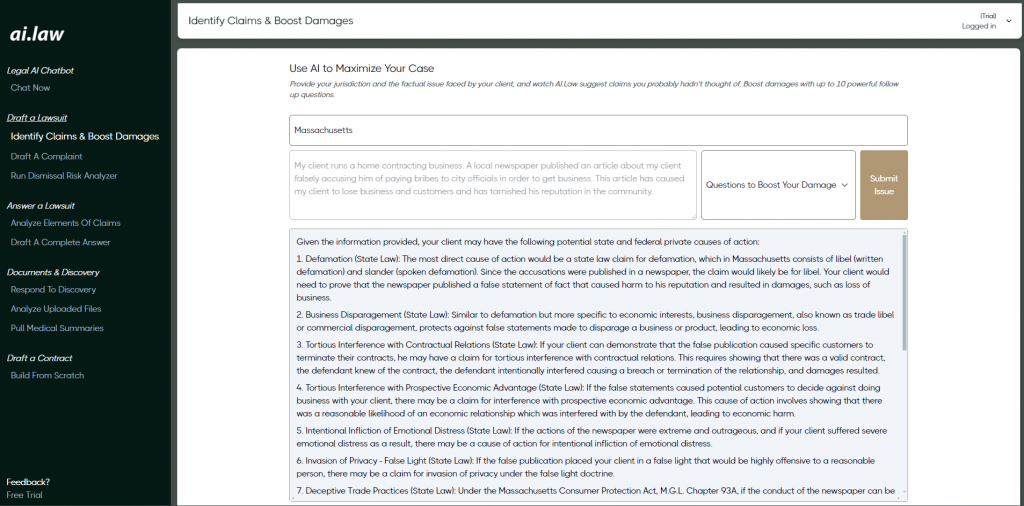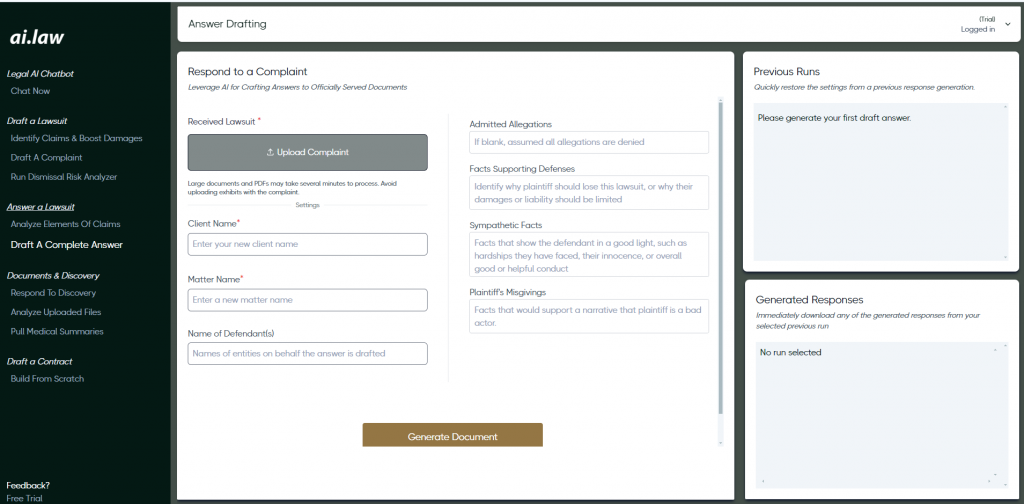Legal Tech Startup Ai.law Now Drafts Complaints for Your Lawsuit
[ad_1]
Ai.lawA legal technology startup that uses artificial-intelligence to generate litigation documents has added a module that will draft a complaint to initiate a suit.
Ai.law had already provided modules for litigation tasks, such as answering a suit, responding to a discovery request, and pulling summaries of medical records. This new module allows users to input relevant information and generate a complaint.
The draft complaint includes jurisdictional accusations, general allegations and claims with elements supported by facts. It also includes a section for demands.
The product, currently in beta, creates a Microsoft Word file formatted specifically for the federal court system. Users in state courts must customize the formatting according to local requirements.
Ai.law will not only draft a complaint but can also suggest what legal claims to include in the lawsuit, or how to increase the damages that you might be able to recover based on the facts and jurisdiction of your case.
Complaints
You fill out a form to draft a complaint. This includes specific information about the case. Ai.law requires that you provide the following information in addition to the names and jurisdiction of the parties:
- Causes of action. If you need help, click to open the tool which suggests claims based upon your facts.
- A description and chronology of events.
- Any issues that are likely to be controversial.
- Facts that will be helpful to your client
- The defendant’s misgivings refers to any facts that may demonstrate the defendant’s lack character or empathy.
- The relief sought.
- Please provide any other instructions.
Once you’ve completed all the fields, click “Generate a Complaint” and a Word file in the form a complete complaint will be downloaded in a matter of seconds.
It should go without saying, but no attorney should ever accept and file this output with a court before carefully reviewing and re-vising it. As mentioned above, you may need to adapt the formatting to suit the requirements of a court where you plan to file it.
Ai.law recommends that you also run your draft complaint through the Dismissal Risk Analysis to check if the allegations are enough.
Give It a Try
I tried it out more as a game than a serious test. I told Ai.law about a fictional scenario where a local newspaper published an article about a building contractor who claimed to have bribed municipal officials for preferential treatment.
On the basis of the information I provided (which was fairly minimal), the application generated a lawsuit that included counts for defamation as well as business disparagement and tortious interference in contractual relations.
You can You can read the complaint that it generated here.
Overall, I thought the complaint was a very good first draft. I would have to research the claims to see if there was anything more to say or if they should be removed, but the initial draft could be a time-saver.
I also thought the language was a bit melodramatic, particularly in the introduction. This opening paragraph is a good example:
“In Boston’s heart, where trust and reputation is the cornerstone of local business John Smith stands out as a paragon for integrity. The Boston Beacon’s reckless words have unfairly tarnished his reputation. Smith Contracting is a business founded on the foundations of honesty and community service. A story that is both false and damaging has cast a shadow over the business. Despite John Smith’s unblemished record of service and his role as a pillar of the community—evidenced by his membership in the Chamber of Commerce and his dedication as a Little League coach—the Boston Beacon has callously sullied his name without regard for the truth.”
Some people may prefer this style, but for those of us that do not, a simple edit would be enough to tone it down. In an email Troy DoucetThe litigator behind Ai.law acknowledged that the language used could be “a little fluffy,” but added that it would be toned-down over time.
Analyzing the Complaint
After using Ai.law for generating a complaint, i turned the tables and uploaded the complaint that it generated. I then asked it to analyze whether the allegations were sufficient and to identify the elements of my claims.
The complaint should describe the elements to be established, and indicate whether it has been addressed.
Ai.law, for example, says that a defamation case requires a showing of the publication’s defamatory nature. AI stated that the statement must be a defamatory statement. The article’s allegations clearly defame the plaintiff, as they accuse him of criminal activity.
The AI stated that the complaint did not meet the requirement of public disclosure of private information. The AI explained that “the disclosed facts must not be of public concern and must be private.” The lawsuit does not establish this element clearly, as it does no detail what private facts have been disclosed, even though it suggests that the article was a matter not of public concern.
I have not evaluated the legal accuracy of Ai.law’s ability to identify and analyze claims. But I will repeat that no lawyer can rely on AI to the exclusion or conducting your own research, analysis and legal and factual issues.
It is worth a try as a tool for generating a first draft.
Free to try
If you are curious to try Ai.law’s complaint generator for your yourself — or any of its AI applications — the company offers a free trial. After the free trail ends, there are three subscription tiers that range from $209 to 649 depending on features.
By the way, this year-old company was among the 15 startups that participated in the Startup Alley competition at ABA TECHSHOW.
[ad_2]




